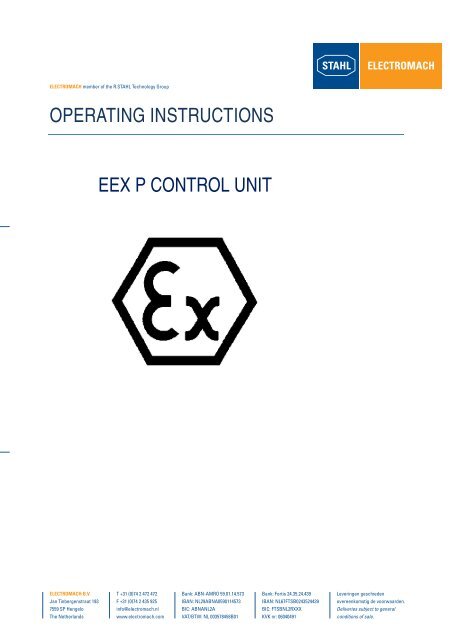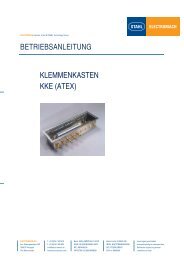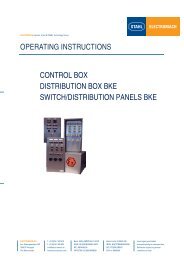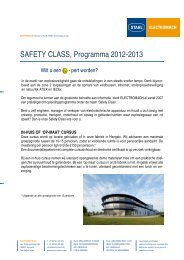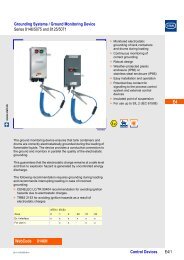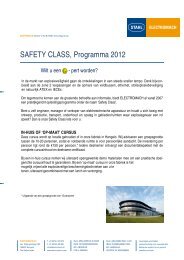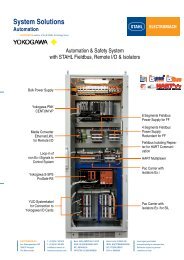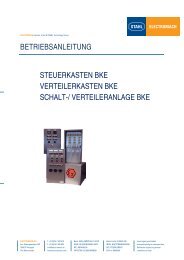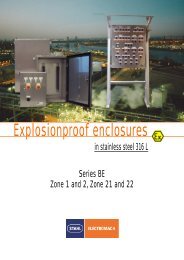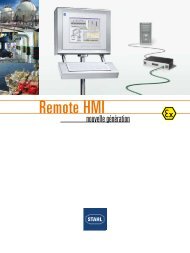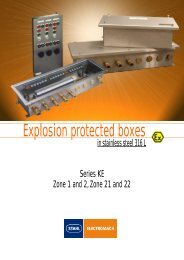operating instructions eex p control unit - Electromach BV
operating instructions eex p control unit - Electromach BV
operating instructions eex p control unit - Electromach BV
You also want an ePaper? Increase the reach of your titles
YUMPU automatically turns print PDFs into web optimized ePapers that Google loves.
<strong>Electromach</strong> member of the R.STAHL Technology GroupOPERATING INSTRUCTIONSEEX P CONTROL UNIT<strong>Electromach</strong> B.V.Jan Tinbergenstraat 1937559 SP HengeloThe NetherlandsT +31 (0)74 2 472 472F +31 (0)74 2 435 925info@electromach.nlwww.electromach.comBank: ABN-AMRO 59.01.14.573IBAN: NL29ABNA0590114573BIC: ABNANL2AVAT/BTW: NL 003578458B01Bank: Fortis 24.35.24.439IBAN: NL67FTSB0243524439BIC: FTSBNL2RXXXKVK nr: 06040491Leveringen geschiedenovereenkomstig de voorwaarden.Deliveries subject to generalconditions of sale.
INDEXOPERATING MANUAL FOR EEXP CONTROL UNIT .................................................................................... 31 SAFETY INSTRUCTIONS .............................................................................................................................. 42 GENERAL REMAKRS AND WARNING NOTES ......................................................................................... 43 NORM COMPLIANCE .................................................................................................................................... 54 TECHNICAL DATA / FUNCTION .................................................................................................................. 54.1 FUNCTION FOR UTILISATION AS A PRESSURISED ENCLOSURE WITH COMPENSATION OFLEAKAGE LOSSES ....................................................................................................................................... 54.2 FUNCTION FOR UTILISATION AS A PRESSURISED ENCLOSURE WITH CONTINUOUS RINSING........................................................................................................................................................................ 74.3 TECHNICAL DATA .................................................................................................................................. 84.4 SCHEMATIC STRUCTURE..................................................................................................................... 94.5 ADJUSTMENT OF AIR VOLUMES ....................................................................................................... 105 CONNECTION OF THE ELECTRICAL WIRES .......................................................................................... 116 STATE TABLE .............................................................................................................................................. 127 SETTING THE PARAMETERS .................................................................................................................... 128 INSTALLATION ............................................................................................................................................ 179 COMMISSIONING ......................................................................................................................................... 1810 MAINTENANCE AND REPAIR .................................................................................................................. 1811 ACCESSORIES / SPARE PARTS ............................................................................................................. 1912 WASTE DISPOSAL .................................................................................................................................... 1913 EC-TYPE EXAMINATION CERTIFICATE ................................................................................................. 2014 DECLARATION OF CONFORMITY .......................................................................................................... 21PAGE 2/ 21
OPERATING MANUAL FOR EEXP CONTROLUNITWhen work takes place in hazardous areas, the human safety and the safety of systems are contingent onthe adherence to all relevant safety regulations.For this reason, the installation and maintenance personnel working in such systems have a specialresponsibility. The precondition for this is an accurate knowledge of the applicable regulations andprovisions.This manual briefly summarises the most important safety measures. It is intended to supplement therelevant regulations which must be studied by the personnel responsible.PAGE 3/ 21
1 SAFETY INSTRUCTIONSOnly employ the <strong>control</strong> <strong>unit</strong> for the permitted purpose. Incorrect or non-permissible deployment and/ornon-compliance with the <strong>instructions</strong> of this <strong>operating</strong> manual shall invalidate any warranty by us.Modifications and constructional alterations to the <strong>control</strong> <strong>unit</strong> which impair the explosion protection are notpermitted.The <strong>control</strong> <strong>unit</strong> must only be operated in an undamaged and clean condition.When installing and <strong>operating</strong> / utilising the <strong>control</strong> <strong>unit</strong>, the following must be paid attention to: The national safety regulations; The national accident-prevention regulations; The national installation and assembly regulations; The generally accepted rules of technology; The safety <strong>instructions</strong> of this <strong>operating</strong> manual; The characteristic values and measurement <strong>operating</strong> conditions specified on the type and dataplates; Other instruction plates / labels on the <strong>control</strong> <strong>unit</strong>.Any damage can compromise and even neutralise the explosion protection.2 GENERAL REMAKRS AND WARNINGNOTES Work on live parts other than intrinsically safe circuits is fundamentally prohibited while a danger ofexplosion exists. A protective-earth conductor must be connected to the protective-earth-conductor connectionbefore any other connections are made. Before switching on, it must be ensured that the <strong>operating</strong> voltage corresponds with the valuesspecified on the type plate.PAGE 4/ 21
It must be ensured that only safety fuses of the specified type and of the nominal (rated) amperagebe utilised as a replacement / as spare parts. The use of shorted-out safety fuses or short-circuitbridges is not permissible. If the possibility exists that safe operation can no longer be ensured, the <strong>control</strong> <strong>unit</strong> must beswitched off and prevented from being switched on again.We will gladly send you a copy of the EU design test certification together with the relevantappendix on request.3 NORM COMPLIANCEThe device fulfils the following regulations and norms: Directive 94/9/EU EN 50014: 1997+A1-A2 EN 50016: 1995 EN 50018: 2000 EN 50019: 2000 EN 50020: 1994 EN 954-1: 19964 TECHNICAL DATA / FUNCTION4.1 FUNCTION FOR UTILISATION AS A PRESSURISED ENCLOSURE WITHCOMPENSATION OF LEAKAGE LOSSESAfter the safety mechanism is switched on, a pressure builds up in the housing.The pressure sensors employed in the display/measurement module monitor the internal pressure of thehousing and the differential pressure on the measurement aperture.If the pre-set measurement values Min A + B and Diff A + B are exceeded, then the pre-set purging timestarts. The relevant LED in the <strong>control</strong> <strong>unit</strong> lights up and the residual purging time in thedisplay/measurement module tends towards zero.PAGE 5/ 21
If, due to an impermissibly high flow resistance on the protective-gas output, a too high housing internalpressure is reached during the purging phase, the purging operation is terminated. It is only possible "afterelimination of the possible cause" to switch on again by pressing the switch S5 of the <strong>control</strong> module (turnto pos. 0, turn back to pos. 1).If a too low protective gas flow is measured on Diff A or Diff B during the purging phase, the residualpurging time is reset to the maximum purging time value.Please check the input pressure on the reducing valve, housing seal, and doorlocks.After the purging time is over, the magnetic-valve protective gas is switched off and the voltage supply ofthe <strong>control</strong> <strong>unit</strong> is enabled via the contacts K2/K3 on terminals 34 and 35. Contacts K4 and K5 switch inaccordance with the configuration. The Operation LED in the <strong>control</strong> <strong>unit</strong> lights up.The required leakage-loss is compensated by the integrated needle valve.The residual purging time display goes out and the existing internal pressure of the housing is displayedon the sensor module.If the housing pressure falls below the switching value Min A or Min B during the <strong>operating</strong> phase, K2/3and the configured K4/5 are released.This switches off the power of any connected non-Ex devices.Simultaneously, a pre-purging phase commences. The voltage is enabled after a time delay(approximately 5 seconds) in order to compensate any possible protective gas fluctuations in the mains.Please check the housing seal, the doorlocks and whether the leakage loss compensation is stilladequate.Please note that if the value in the display/measurement module PD1 sinks below the pre-set value (DP1),the magnetic valve opens briefly in an attempt to compensate a leakage loss.This triggering of the magnetic valve usually indicates that the sealing of the system needs to be checked.If the housing pressure exceeds the switching value "Max" during the <strong>operating</strong> phase, the power ofterminals 34 and 35 is switched off immediately but only for the duration of the excess pressure. After thepressure falls back below the "Max" value, the system is switched on again without delay. Please verify thesafety function (relief) of the measurement aperture.PAGE 6/ 21
The purging time and switching values of the pressure switches are pre-set at the factory. This alsoapplies for relays K4/5.4.2 FUNCTION FOR UTILISATION AS A PRESSURISED ENCLOSURE WITHCONTINUOUS RINSINGAfter the safety mechanism is switched on, a pressure builds up in the housing.The pressure sensors in the display/measurement module monitor the internal pressure of the housingand the differential pressure on the measuring aperture. If the pre-set measurement values Min A + B andDiff A + B are exceeded, then the pre-set purging time starts. The relevant LED in the <strong>control</strong> <strong>unit</strong> lights upand the residual purging time in the display/measurement module tends towards zero.If too high a housing internal pressure is reached during the purging phase due to an impermissibly highflow resistance on the protective-gas output, the purging operation is terminated. It is only possible "afterelimination of the possible cause" to switch on again by pressing the switch S5 of the <strong>control</strong> module (turnto pos. 0, turn back to pos. 1).If a too low protective-gas flow is measured on Diff A or Diff B during the purging phase, then the residualpurging time is reset to the maximum purging time value.Please check the input pressure on the reducing valve, housing seal and doorlocks.After the purging time has elapsed, the voltage supply of the <strong>control</strong> <strong>unit</strong> is enabled via the contacts K2/K3on terminals 34 and 35. Contacts K4 and K5 switch in accordance with the configuration. The OperationLED in the <strong>control</strong> module lights up. The residual-purging-time display goes out and the existing housinginternal pressure is indicated on the sensor module.If the housing pressure falls below the switching value Min A or Min B during the <strong>operating</strong> phase, K2/3and the configured K4/5 are released. This switches off the power of any connected non-Ex devices.Simultaneously, a new pre-purging phase commences. The voltage is enabled after a time delay(approximately 5 seconds) in order to compensate any possible protective gas fluctuations in the mains.Please check the housing seal, the doorlocks and whether the input pressure is still adequate.PAGE 7/ 21
If the housing pressure exceeds the switching value "Max" during the <strong>operating</strong> phase, the power ofterminals 34 and 35 is switched off immediately but only for the duration of the excess pressure. After thepressure falls back below the "Max" value, the system is switched on again without delay. Please checkthe input pressure and that the measurement aperture is functioning correctly.The purging time and switching values of the pressure switches are pre-set at the factory. This alsoapplies for relays K4/5.4.3 TECHNICAL DATAExplosion protectionEExp ....IIB/C T4 ... 6Test certificateDMT 01ATEX E116UAmbient temperature During storage and transport -20° ... + 80°Operation -20° ... + 40°Degree of protection to IEC/CEI 60529max. IP 54, minimumPermissible humidity< 90% relative humidity, annual averageMeasurement <strong>operating</strong> voltage 230 VAC 48-62 Hz (± 10%)Optional 115 VAC (± 10%)Purging timeAdjustable from 0-99 min.Pressure valuesTolerance of each pressure sensor ± 2% of therangeSensor rangeSystem range mbarSensor range 0-25 0-300 0-1000DIFF A 0-25 0-29.9 0-29.9DIFF B 0-25 0-29.9 0-1000MIN A 0-25 0-300 0-1000MIN B 0-25 0-300 0-1000MAX 0-25 0-300 0-1000MAX1 0-25 0-300 0-1000Conversion100 Pa = 1 mbar = 0.001 N/m³ = 10 mm WS1 bar = 0.1 mPaRelays K2/3 Switching capacity max. 5A for cos phi = 1 (253VAC). Time delay 5 sec.PAGE 8/ 21
Relays K4 and K5Output A1Connection terminalsProtective gasTemperature <strong>control</strong> (optional)Safety-related valuesMax. 100mA / 10VMax. 30 mA / 30VConnection of the input valve max. 7 VAMax. 1x 2.5mm² per terminalInert gas or dry, oil-free industrial compressed airThermostat (NO, closing)4.4 SCHEMATIC STRUCTUREPAGE 9/ 21
4.5 ADJUSTMENT OF AIR VOLUMESPurging-air volumes and compensation leakage air losses are values determined at the factory.If necessary, the setting for leakage air loss can be adjusted as follows.GehäusewandRinsing-air nozzleLeakage-airnozzle withsound absorberMax: d=2.5mm_+The air volume can be varied by turning the adjustment screw (which is accessible through the purging-airnozzle) to the necessary value using a suitable screwdriver. (Turning in the counter-clockwise directionincreases the leakage-loss volume)PAGE 10/ 21
5 CONNECTION OF THE ELECTRICAL WIRESPAGE 11/ 21
6 STATE TABLEThe monitoring <strong>unit</strong> is constructed in accordance with EN 50016 and satisfies the requirements specifiedtherein. The workflows of the various states are detailed below.STATECONDITIONS, ALL OF WHICH MUST BEFULFILLEDRESULT WHEN ALLCONDITIONS ARE SATISFIEDPreparation for the start ofthe <strong>control</strong> devicePre-purging is runningPre-purging finished.Voltage supply of the non-Ex devices switched ona) Mains voltage connectedb) Internal pressure less than MAXc) Pre-purging time determined and setd) Pre-purging time has not elapsed Control device ready for prepurginga) Internal pressure greater than MIN Ab) Internal pressure greater than MIN Bc) Internal pressure less than MAXd) Minimum flow greater than DIFF Ae) Minimum flow greater than DIFF Bf) Pre-purging time has not elapsed Pre-purging time is runninga) Internal pressure greater than MIN Ab) Internal pressure greater than MIN Bc) Internal pressure less than MAXd) Pre-purging time has elapsede) ON/OFF switch closed K2/K3 closedK4/K5 closed7 SETTING THE PARAMETERSAll parameters such as Min A, Min B, Diff A, Diff B, Max/DP1, function K4/K5, purging time, temperatureadjustment, time delay for switching off the power are set at the factory.If the pre-settings or the <strong>control</strong> <strong>unit</strong> are modified without the written consent of <strong>Electromach</strong>, then thewarranty is invalidated.PAGE 12/ 21
Rotary switch S 5 of the <strong>control</strong> moduleRotary switch S 5 is a reset switch and is used to restart the system during adjustment operations.Rotary switches S 2 to S 4 of the <strong>control</strong> moduleThe purging time is set using the rotary switches S 2 to S 4. It is possible to set the minutes in steps of 10and 1. The seconds can only be set in steps of 10.Rotary switch S 1 of the <strong>control</strong> moduleThe various switching values of the <strong>control</strong> devices can be displayed and adjusted using rotary switch S 1.The following parameters are assigned to the switch positions:SWITCH POSITIONPARAMETER0 Display of the internal pressure of the housing, target / referencevalue and residual-purging-time value1 Display of set point value "DIFF A" and actual value2 Display of set point "DIFF B" and actual value3 Display of set point "MIN A" and actual value4 Display of set point "MIN B" and actual value5 Display of set point "MAX" and actual value6 Max 17 Min P8 Display of the function of "K4"9 Display of the function of "K5"Switches S 11 to S 13 of the display/measurement module 8625/1-30-25Switches S 11 to S 13 are used for changing and storing set points selected using S 1. A change of valueis only possible after connection of the safety bridge on terminals 23 and 24./0…300 mbarDIFF A000,0mbar000,5Actual valueSwitching valueTarget valuePAGE 13/ 21S11 - S12+ S13 SET
Pressing the + or - keys once causes the value to change by 0.1 mBar. After pressing more than 25 valuescontinuously, the value changes in steps of 1 mBar. By pressing the - key, the value can be changed to aminimum of zero. By pressing the + key, the value can be changed to a maximum of 100% of the currentvalue. The stored value is indicated by a ".".Switch S 1 to position 8 and 9By pressing the + or - key, it is possible to select between function 0 and function 10 for the relaysA function change does not take place until after the system is restarted using S 5.Switch positionParameter0 Switches at the same time as K21 Switches if the set point of DIFF A is exceeded2 Switches if the set point of DIFF B is exceeded3 Switches if the set point of MIN A is exceeded4 Switches if the set point of MAX is exceeded5 Not used6 Switches if the purging time counts off7 Not used8 Switches if the key-switch is set to bypass9 Switches at an internal malfunctionBypass key-switchThe bypass key-switch switches off the safety mechanism.When the bypass key switch is pressed, the LCD display of the display/measurement module indicates thefollowing:K2 FunctionK2 FunctionClose K2Open K2With “+” With “-“PAGE 14/ 21
The pushbutton switches + and - on the display/measurement module can be used to switch the releaseprotection on and off.Parameters of the <strong>control</strong> device can be modified by manufacturers using the RS 485 interface.However, parameters can only modified by authorised personnel because functionalchanges invalidate the EU design test certification and conformity declaration.Because of "danger of explosion", special permission must be obtained before pressing thebypass key-switch.After properly connecting all external electrical and mechanical equipment, a check should first be madethat the electrical equipment is set up and connected correctly.Malfunction Possible cause RemedyDevice is not <strong>operating</strong>, LED"Mains" is not lightingThe electrical devices areconnected without a prepurgingphaseLED "Purging time is running"does not flash during thepurging timeMains voltage not connectedDevice defectiveKey switch switched on, bridge onterminals 17 and 18Protective gas not connectedEEx digital valve does not openCheck the mains-voltage supplywireSwitch off key switch, removebridgeConnect protective gasCheck that the supply voltage(terminals 31 to 33) is connectedto the digital valveCheck the valve connection toensure that extraneous particlesare not present in the mechanicalpart.PAGE 15/ 21
After the pre-purging phase,EEx digital valve does notswitch over to the small nozzle(only under § 5.1)The <strong>control</strong> device does notconnect the electrical devicesafter the pre-purging phaseAfter the purging time, the<strong>control</strong> device switches off theelectrical devices after a timeA sufficient volume of protective gasis not flowing through the Ex-phousingThe nominal / required pressure ofthe reducing valve is not attainedDuring the pre-purging phase,housing is leaking on account ofexcessive internal pressure.Valve connection does not closeTemperature sensor is connected.Internal temperature is too highON/OFF switch / bridge is notconnected on terminals 19 and 20Pressure in the housing exceeds theswitching value of "MAX"Housing has a leak, pressureswitches "MIN A "and "MIN B" settoo lowIncrease the input pressure to thenominal / required valueProtective-gas supply too low.Increase the cross-sectional areaof the supply lineSeal the housing by takingappropriate measuresCheck that the supply voltage ofthe valve connection is switchedoffCheck that there are noextraneous particles in themechanical part of the valveconnectionWait until the internal temperaturehas dropped as a result of theincreased flow, or else check thesetting of the temperatureswitching valueTurn on the ON/OFF switch /connect bridge on terminals 19and 20Reduce the air flow of the leakageair nozzleSeal the housingPAGE 16/ 21
delay of 5 seconds.Digital valve connectstemporarily during the<strong>operating</strong> phase (only under §5.0)When the pressure drops, theelectrical devices do not switchoffLeakage compensation valve on thedigital valve is too smallHousing has a leak, valve connectionattempts to retain the internalpressure level by opening thepurging-air nozzleIs the bridging key switch switchedon?Increase the air flow of theleakage-air nozzleSeal the housing or increase theflow capacity of the leakage-airnozzleSwitch off the key switchPlease consult with <strong>Electromach</strong> b.v. before <strong>operating</strong> under conditions which deviate fromthe standard <strong>operating</strong> conditions!8 INSTALLATIONMains connection: The wiring connection must be made very meticulously; The wiring insulation must extend all the way to the terminal. When baring wires, the conductoritself must not be damaged (notched); By appropriately choosing the wires being utilised and by properly laying the wires, it must beensured that the maximum permissible conductor temperatures are not exceeded; Pay attention to the specifications in the technical data relating to the terminals; Protect the measurement aperture against spraying water.Additional specificationsProtective-earth conductor connection:The connection of a protective-earth conductor is essential / potential equalisationPAGE 17/ 21
9 COMMISSIONINGBefore you commission the <strong>control</strong> <strong>unit</strong>, please ensure that: the <strong>control</strong> <strong>unit</strong> was installed in accordance with the regulations; the equipment is not damaged; no extraneous particles are present in the <strong>control</strong> <strong>unit</strong>; the <strong>control</strong> <strong>unit</strong> is connected correctly; the cables are inserted properly; all bolts and nuts are tightened firmly; the wires are connected firmly; unutilised wire entry points are sealed with plugs which are certified in accordance with Directive94/9/EU and unused drill holes are sealed with plugs which are certified in accordance withDirective 94/9/EU.10 MAINTENANCE AND REPAIRMaintenance, repair and servicing work on the EEx devices must only be performed by personnel who areboth authorised and suitably trained for this purpose. Before commencing any such work, switch off thepower of the devices.Please pay attention to the national regulations applicable in the country of deployment!The following points must be verified before any maintenance work is carried out: that the terminal wires are properly positioned; that the correct <strong>operating</strong> temperature is the case; that the switch cabinet is sealed.PAGE 18/ 21
11 ACCESSORIES / SPARE PARTSOnly use original accessories and original spare parts manufactured by R.STAHL/<strong>Electromach</strong> b.v.12 WASTE DISPOSALPlease observe your national waste-disposal regulationsIf you have any specific questions, do not hesitate to contact us. Please contact the R.STAHL / <strong>Electromach</strong> organisation responsible.PAGE 19/ 21
13 EC-TYPE EXAMINATION CERTIFICATEPAGE 20/ 21
14 DECLARATION OF CONFORMITYPAGE 21/ 21


